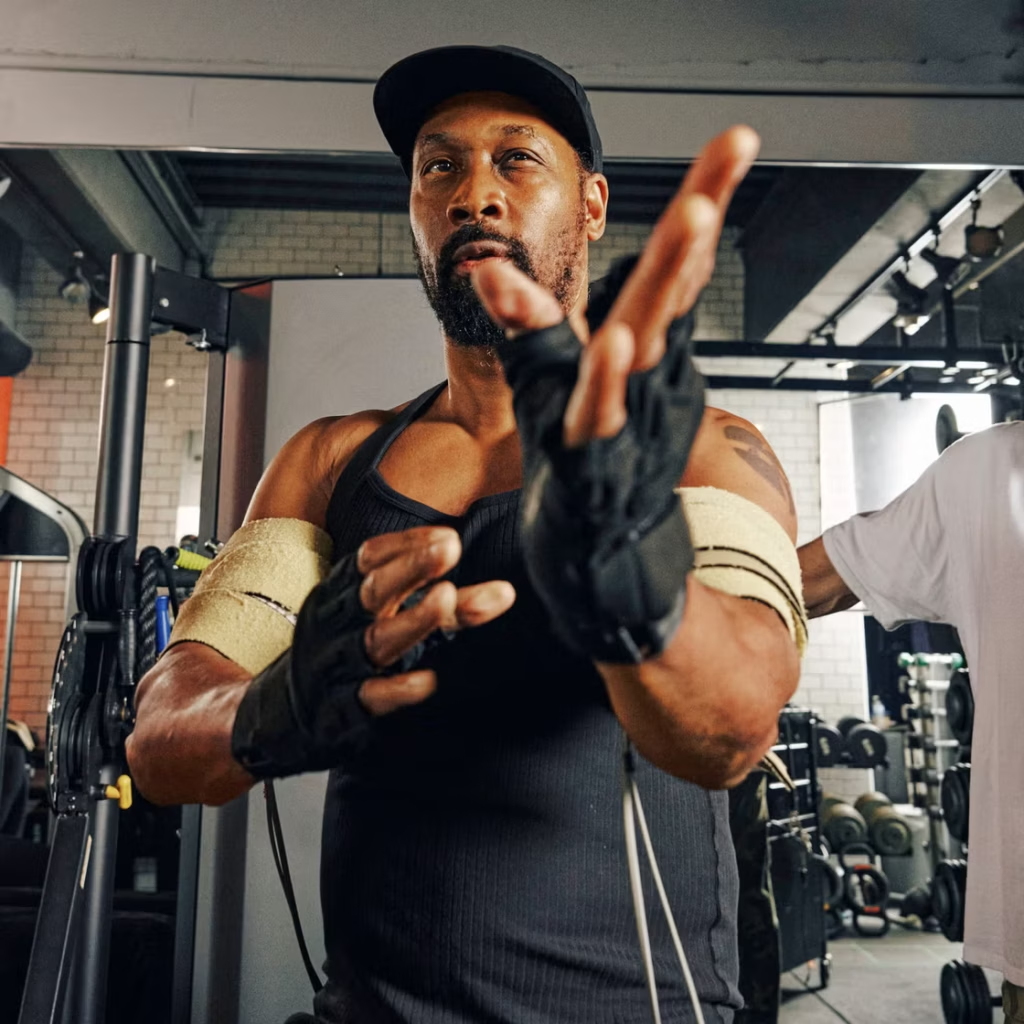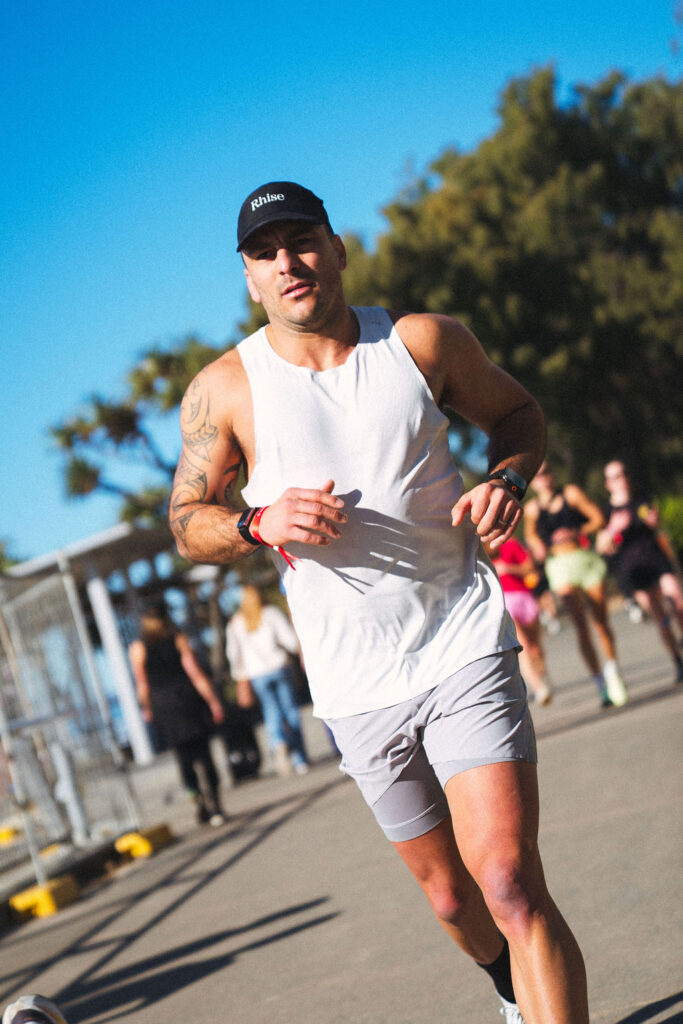Want to be a fitter, leaner, happier man? Don your sweat-wicking shorts, lace up your trainers and chase down the benefits of running. Put foot to floor on your lunch break, and in return for sweaty brows and sore legs, you’ll stoke your metabolism, relieve stress and boost your attention span all afternoon long.
If swapping gym time for jogging doesn’t immediately appeal, don’t park your running shoes just yet. You needn’t mirror the training regimen of record-breaking marathoner Eliud Kipchoge to reap the potent benefits of running, because, as you’ll discover, the most visceral perks associated with pounding tarmac are near-instantaneous.
Whether you’re eyeing up a race or just want to lap your local park, with our guide, your next kay will be your best.
Below, we reveal the postural tips you need to master your technique, lay out your route to the 5K finish line, and reveal
12 potent benefits of running that’ll kick in before you have time to untie your shoes. Just take it all in your stride, yeah?
How to master your running technique
“Good posture begins with your head,” advises elite distance runner Jonny Mellor, British Champion at the London Marathon 2020 and founder of JM Coaching. “Look ahead with your eyes focused on the ground approximately five to
six metres in front. Keeping your chin parallel to the ground will ensure you don’t lean too far forwards or backwards.
“Relaxed shoulders are key to enable your arms to swing backwards and forwards beside your body,” Mellor continues. Avoid cross-body arm movements, and resist the urge to make a tight fist. “Imagine you’re holding an egg,”
he says. “You want to hold the egg without dropping it, but equally not so hard that you squash the egg in your hands.”
Keep your hips level with your pelvis. “This is why a strong core is important – to prevent the pelvis from tilting forward and pushing the hips back,” Mellor advises. “Often when runners have a tight lower back, it’s a result of tight hip flexors.” Despite what your Park Run-mad neighbour might tell you, it’s not worth getting hung up over your ‘foot strike’.
“You can be a rearfoot, midfoot or forefoot runner, depending on how your foot hits the ground,” says Mellor. “Stick with what naturally occurs for you, unless you’re getting repeated injuries in this area. Your body will adapt to the forces you put through it. Focus on improving your posture further up your body instead.”
The most common posture error? “Running too stiff and rigid,” says Mellor. “If your spine is too rigid or you’re tight in your upper back, it can have a knock-on effect further down the chain and can result in injury.” Be loose, but don’t flail your hands around – in terms of movement patterns, “think tossing pancakes rather than frying sausages,” he says.
“Often runners don’t use their arms enough, which means they don’t get the same drive and power from their stride,” Mellor adds. “Short hill sprints – 10-15-seconds in duration – are a great way to practise form and technique and improve that drive phase.” Walk back to recover and repeat 4-6 times. “It’s a great way to work on your form,” he says.
How to train for a 5k as a beginner
If your only marathon experience consists of the Netflix variety, this plan will get you out the door. Designed by Tim Benjamin, former Olympic runner, current Team GB Olympic coach and co-founder of audio-fitness app WithU, it’ll build you up from walking to running a full 5km within eight weeks. “Each week will progressively increase the time spent running and reduce the walking time in-between,” he says.
To get the most out of the plan, forget pace and focus on effort. “Your pace may change due to a variety of factors, including the weather, elevation, sleep, fatigue and stress,” says Benjamin. “Listen to your body and try not to push too hard when your body isn’t feeling up to it. Some days you may find the runs easy, some days will feel super challenging.”
If you miss a day, no sweat. Just reset and jump in where you left off, Benjamin advises. “All athletes have down days so don’t get too hung up on it. You’re in control of what you put into the program and therefore what you get out of it.” And don’t skip the recovery days – they’re just as important for your progress. Stretch, drink plenty of water and refuel.
When it’s time to warm up, “never, ever stretch a cold muscle,” says Rob Jones, running endurance performance coach at InnerFight. “That means no static stretches. Studies from the Journal of Science and Medicine in Sport show you will suffer negative running effects for up to two hours after the stretch.
It switches off the muscles and tendons, decreasing the ability to transmit force effectively, which makes them weaker, slower, less efficient, and ultimately compromises your endurance.”
If you have a long, easy training session planned, spend the first 10 minutes jogging (or walking, if you’re new to running) at a comfortable pace and you’re ready to go. However, if you are about to tackle a speed, tempo or race session, Jones recommends focusing on:
Low-intensity Rhythmic Activity: “A nice gentle run [or walk, if a beginner] to allow your heart rate and body temperature to elevate – five to 10 minutes is enough”.
Dynamic Drills: “Put muscles through the range of motion you will experience in the session, such as a forward lunge with overhead reach, or a lateral windmill lunge”.
Skill-specific Movement: “If you’re racing, spend a few minutes at goal race pace. If you are running a speed session, run some strides.”
After your run, “finish with an easy 400-800 metres to let the heart rate come down slowly and clear any lactate from the muscles,” says Jones. “Lots of research out there shows that post-run static stretches do not help with recovery or preventing DOMS. If you’re stretching for the purpose of preventing injury, your time would be better spent working on drills to improve running form, or strength work.”
You heard the man – training for a race is no excuse to skip the squat rack. “Strength training is the missing piece of the puzzle that the majority of runners neglect, or swap out, when their running volume increases,” he advises. “Strong runners run faster, for longer, without injury – it’s that simple. Every runner, from weekend warrior to Boston Marathon qualifier, should be incorporating some form of resistance training into their program.”
For runners, “the best type of strength training is run-specific, training the muscles and patterns you will use in your running,” says Jones. Think: hip thrusts, elevated glute bridges, elevated hamstring bridges, split squats and Bulgarian split squats for your lower body; flutter kicks, tuck sit-ups and hollow holds for your core. He suggests three 45-minute sessions per week: two following a push/pull/core format, and one lower body.
Eat kms for breakfast
You don’t need to schedule a monster carb-load the night before each session, but do prioritise the macro in your daily diet. “Without enough carbohydrates, your performance will be impacted,” says Benjamin. “Eating a well-balanced diet rich in carbohydrates, moderate in protein and low in fat will keep your glycogen levels topped up.”
Fuelling your training is key. Typically, a quick bite between 30 -60 minutes before you run – or a meal three hours prior – is recommended for a balance of fuel and fullness, he says. Think: peanut butter and jam on toast, yoghurt with blueberries and granola, oats with banana and almonds, or a bowl of cereal topped with milk and strawberries.
“Adequate protein before exercise and throughout your training season will build and repair muscle tissue and may help reduce post-exercise muscle soreness,” says Benjamin. “Aim to eat something within an hour of your run that includes carbohydrates and protein. A protein shake with carbs is a great solution until you can have a proper meal.”
10 benefits of running you’ll feel immediately
While you won’t necessarily feel physically fitter right away, some benefits of running are near-instantaneous. From an attention boost to better sleep, these evidence-based perks are accessible after a few laps of the park. Here’s how you’ll hit the ground running:
1/ Makesyou happy
A brighter mood isn’t exclusive to the elusive runner’s high, which comes after an hour of pavement pounding. Five kays or so is enough to turn your day around, lifting your mood as effectively as an antidepressant, research from Karolinska University Hospital found.
2/ Relieves stress
Just 20 minutes of running is enough to mitigate work deadlines. In a study conducted by Asics via Kings College London, amateur runners experienced a 29 per cent increase in their ability to deal with stress and saw an 18 per cent boost in relaxation levels.
3/ Running burns kilojoules
Precisely how many kilojoules you’ll burn depends on your weight, your pace and the duration of your run. Lacing up for 30 minutes could burn anywhere from 840-2100 kJs. As a general rule, though, you can expect to burn roughly 200 kilojoules per kilometre.
4/ Boosts learning & memory
When you head out for a run immediately after learning something new, you’ll process and retain the information way more effectively than if you fill the time by playing a computer game, a study published in Cognitive Systems Research concluded.
5/ Running Dampens Inflammation
Just 20 minutes of running suppresses inflammation, the University of California found. When inflammation is left unchecked – known as chronic – it causes damage that leads to serious health conditions like heart disease, diabetes, cancer and arthritis.
6/ Lifts sleep performance
Endurance exercise in the morning improves your kip the following night, research published in the International SportMed Journal concluded. Not only will you nod off faster, but you’ll sleep for longer and enjoy a sounder (less restless) night’s sleep.
7/ Boosts metabolism
Endurance exercise stokes your metabolic fires by hiking up production of the hormone FGF21, according to research in the Journal of Clinical Investigation Insight. FGF21 influences your preference for sweet foods and drinks, and essentially puts the brakes on cravings.
8/ Provides an energy boost
Exhausted, overworked and experiencing the cumulative effects of poor sleep? It sounds sadistic, but lacing up is the solution. A 20-minute session of low- or moderate-intensity exercise boosts your energy levels by 20 per cent, a University of Georgia study found.
9/ Provides confidence boost
Skip the shirtless mirror affirmations and hit the road, instead. Exercise inflates your ego, regardless of whether you actually lose fat, build muscle or get fitter, a meta-analysis published in the Journal of Health Psychology found.
10/ Increases attention span
If you’re struggling to focus on that work report, tame your wandering brain with a trip around the block. Just 12 minutes of exercise is enough to improve your attention span and reading comprehension, researchers from Dartmouth College discovered.
11/ Lowers blood pressure
High blood pressure can harden your arteries, increasing your risk of heart attack and stroke. Running counteracts this by relaxing stiff blood vessels, which allows blood to flow easily. Just 15 minutes per day is enough to slash your risk of dying from heart conditions by 15 per cent, Taiwan’s Institute of Population Science found.
12/ Improves insulin sensitivity
Your blood sugar gradually declines during a run as your muscles begin using glucose for energy. A single bout of moderate-intensity endurance exercise increases whole-body glucose uptake for at least 48 hours into recovery, research published in The BMJ found.
MH Running gear picks

2XU Light Speed Compression Tights
2XU’s Light Speed Compression Tights feature Muscle Containment Stamping (MCS) technology, and are developed with a detailed understanding of the impact running has on the legs, reducing muscle movement, damage and fatigue for your best run yet.















